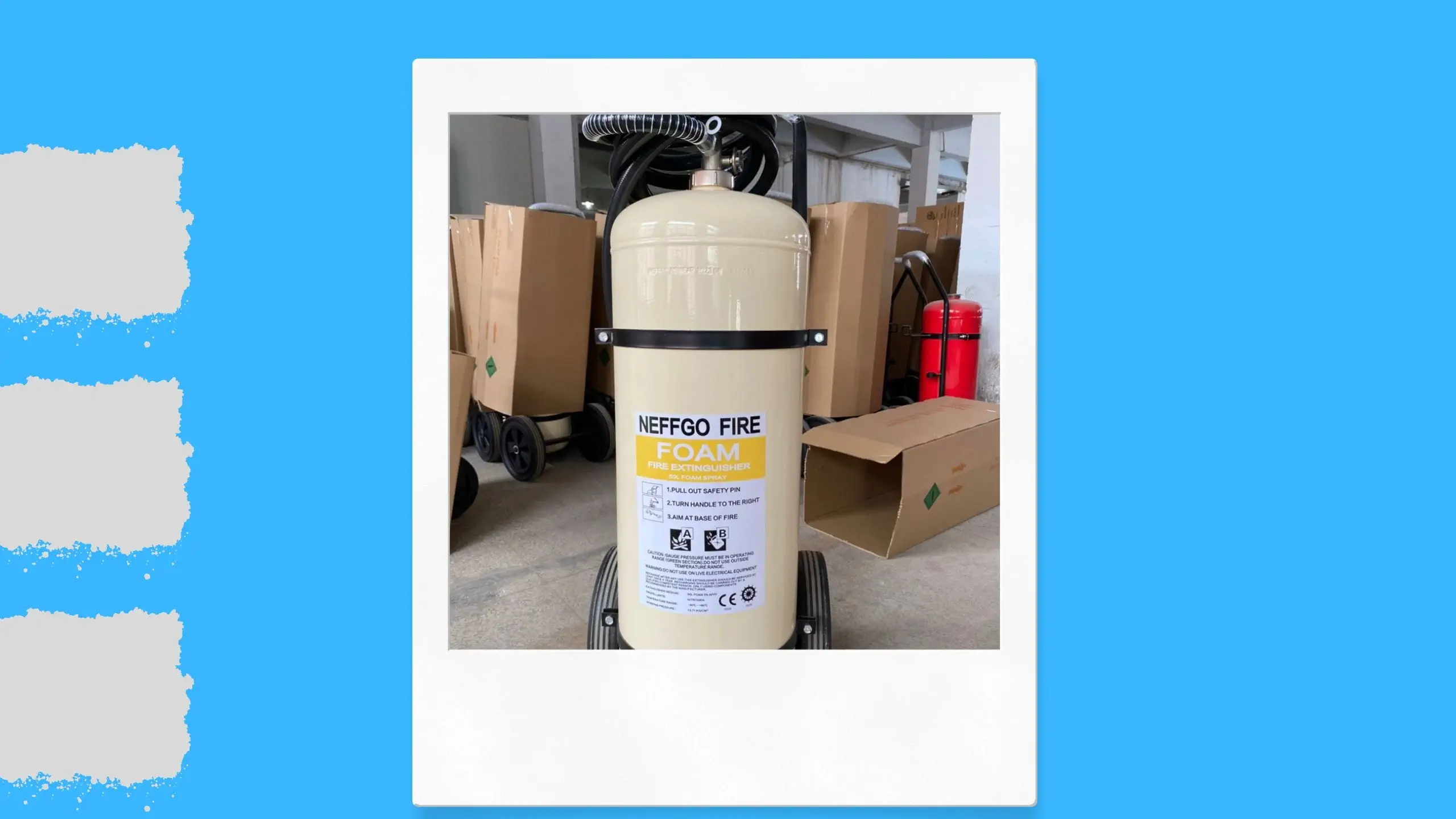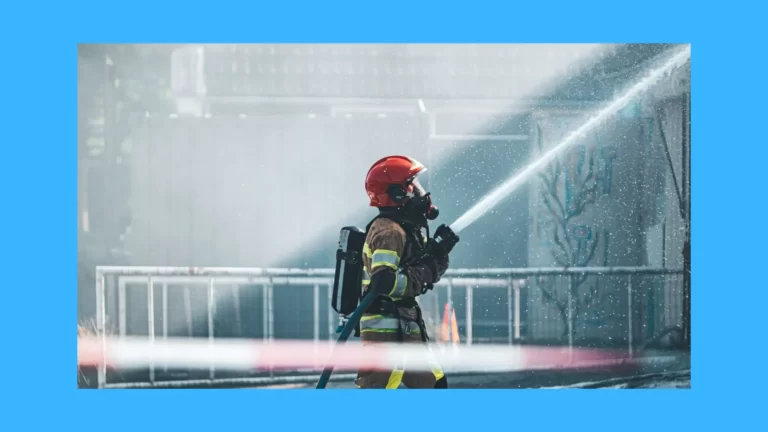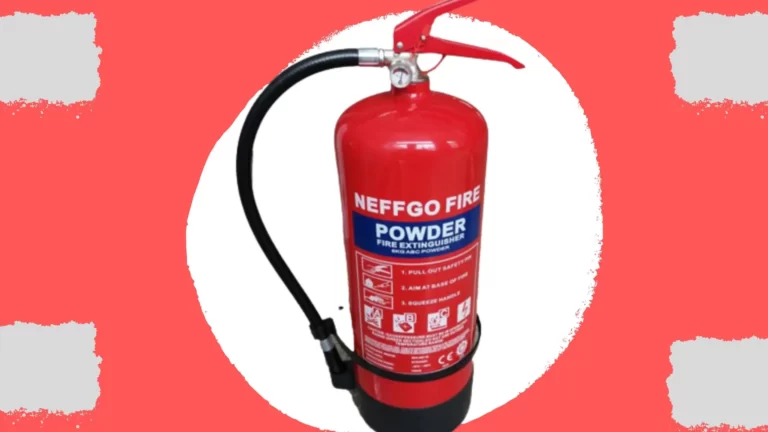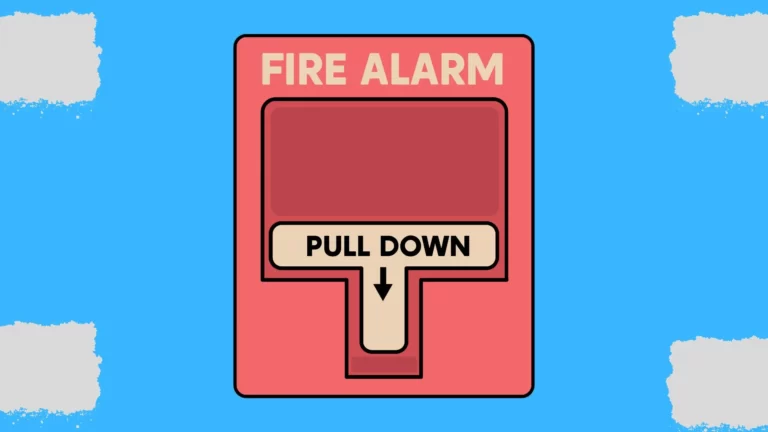The Right Fire Equipment for Homes, Businesses, Churches
Fires can be dangerous and cause significant damage to homes, businesses, and even places of worship. That’s why it is crucial to understand how to choose the right fire equipment for different spaces. In this article, we will explore the importance of fire safety and guide you in selecting the appropriate fire equipment for your residential, commercial, or religious spaces.
Fire safety is all about preventing fires and being prepared in case one breaks out. It is essential because fires can spread quickly, destroy property, harm people, and even cause loss of life. By learning about fire safety and choosing the right fire equipment, you can protect yourself, your loved ones, and your belongings.
We will discuss fire extinguishers, fire alarms and detection systems, fire suppression systems, emergency lighting, and exit signs. Each of these equipment types serves a specific purpose in preventing and responding to fires.
Remember, fire safety is not something to be taken lightly. By learning how to choose the right fire equipment, you can significantly reduce the risk of fires and protect yourself and others. So let’s dive into the world of fire safety and equip ourselves with the knowledge needed to make informed decisions when it comes to fire equipment selection. Together, we can create safer homes, businesses, and communities.
Assessing Fire Risks
To ensure the safety of commercial, residential, or even religious spaces, it is essential to identify potential fire hazards and understand the common causes of fires in each setting.
In residential settings, potential fire hazards can include faulty electrical wiring, overloaded power outlets, unattended candles or stoves, and flammable materials near heat sources.
For example, someone can forget to blow out a candle before going to bed. And the flame can ignite nearby curtains, leading to a dangerous fire. Identifying such hazards and taking preventive measures can significantly reduce the risk of fires at home.
In commercial settings, fire hazards can arise from improper storage of flammable materials, damaged electrical equipment, or blocked emergency exits.
A common cause of fires in offices is the misuse or overloading of power outlets with multiple devices. This can lead to overheating and potential fires.
Conducting regular inspections, training employees on fire safety protocols, and keeping fire extinguishers accessible can greatly enhance fire safety in commercial spaces.
Religious places, such as churches or mosques, may have unique fire risks. For instance, candles used for religious ceremonies can be a hazard if left unattended or placed near flammable materials.
Electrical wiring in older religious buildings may also pose a fire risk if not properly maintained. It is essential to educate community members about fire safety practices and ensure proper fire detection and suppression systems are in place.
Conducting a fire risk assessment is vital to identify these potential hazards and take necessary precautions. It involves inspecting the space, noting potential fire risks, and implementing preventive measures. By conducting regular assessments, you can proactively address fire safety concerns and minimize the risk of fires.
Remember, fire safety is everyone’s responsibility. By being aware of fire hazards in different settings and conducting fire risk assessments, we can create safer environments for ourselves and others.
Fire Extinguishers
When a fire breaks out, having the right fire extinguisher can make all the difference in extinguishing the flames quickly and safely.
There are different classes of fires:
Class A Fires are fires in ordinary combustible materials like wood, plastic, cloth or paper and s forth.
Class B Fires are fires in flammable liquids such as gasoline, oil, alcohol, lacquer, oil-based paints, and so on.
Class C Fires are fires in electrical gadgets.
Class D Fires are fires involving flammable metals.
Class K Fires are fires involving cooking oils and fats.
There are different types of fire extinguishers. Each type has the class or classes of fire it is designed for. Understanding the types of fires and their corresponding fire classes will guide you in selecting the appropriate fire extinguisher.
Choosing the right fire extinguisher involves considering the potential fire hazards in your space. For example, CO2 Fire Extinguishers are manufactured to be used for Class A, B, and C fires. Powder Fire Extinguishers are to be used for Class A, B, and C fires.
You can know by looking at the fire classes stated on the fire extinguisher’s label. See the image below.
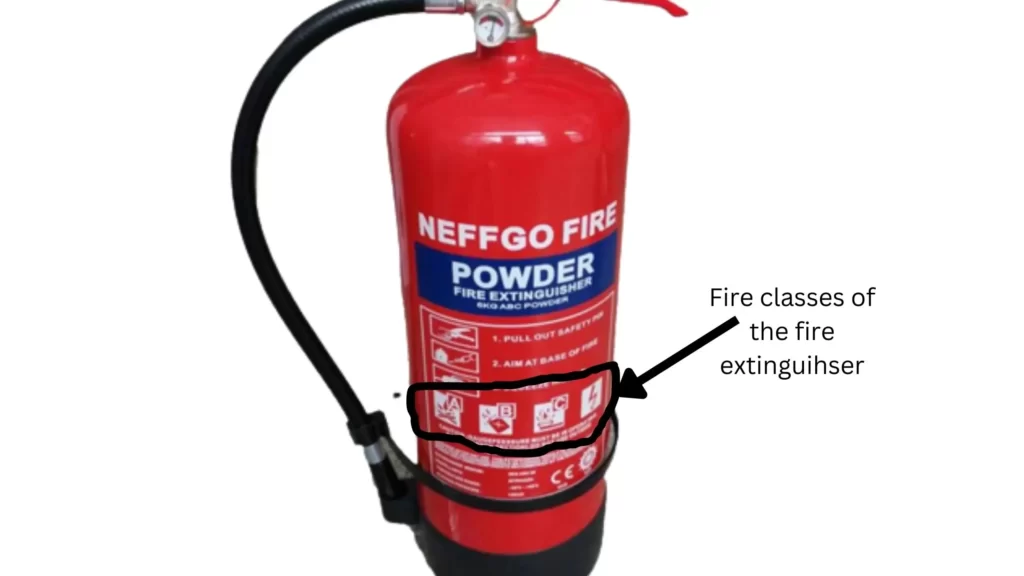
So, for example, if you have a kitchen where cooking oils and fats are used, a Class K extinguisher specifically designed for kitchen fires is recommended.
In an office setting with electrical equipment, a Class C extinguisher is essential.
By understanding the fire classes and assessing the specific fire risks in your environment, you can ensure you have the right fire extinguisher on hand to tackle any potential fire situation.
Maintenance and inspection of fire extinguishers are vital to their effectiveness. Regular visual inspections should be conducted to ensure the extinguisher is easily accessible, the pressure gauge indicates it is charged, and there are no visible signs of damage or corrosion.
Additionally, professional inspections and servicing should be scheduled as recommended by the manufacturer or local fire safety regulations. Proper maintenance and inspections guarantee that the fire extinguisher is in good working condition and ready to be used in case of an emergency.
Remember, fire extinguishers are valuable tools in fire safety, but they must be selected correctly, properly maintained, and regularly inspected to ensure their reliability. By understanding the types of fire extinguishers, choosing the right one based on fire classes, and staying diligent in their maintenance, you can be prepared to face fires confidently.
Fire Alarms and Detection Systems
Fire alarms and detection systems alert us to the presence of a fire and allow us to take swift action.
They can detect smoke, heat, or flames and trigger alarms to alert occupants to evacuate and seek safety. Early detection is crucial because it allows people to escape before the fire grows, and it enables emergency services to respond quickly.
There are different types of fire alarms and detectors available.
Smoke detectors are the most common and can sense the presence of smoke particles in the air.
Heat detectors respond to rising temperatures, while flame detectors are designed to detect the presence of open flames.
Combination detectors, which incorporate multiple sensing technologies, are also available. Each type has its own advantages and is suited for specific environments and fire hazards.
When choosing a fire alarm and detection system, several considerations should be taken into account. Firstly, assess the specific fire risks in your environment. For instance, if your space has high levels of smoke from cooking or industrial processes, smoke detectors are essential.
Secondly, consider the size and layout of the area to be covered to determine the number and placement of detectors for maximum coverage.
Thirdly, ensure that the system meets Ghana’s fire safety regulations and standards.
Fire Suppression Systems
Fire suppression systems are essential tools designed to control or extinguish fires, safeguarding lives and property.
Fire suppression systems come in different forms, with two common types being sprinkler systems and gas suppression systems.
Sprinkler systems are widely used and consist of water-filled pipes with sprinkler heads that release water when activated by heat or smoke.
Gas suppression systems, on the other hand, use special gases, such as carbon dioxide or clean agents, to displace oxygen and suppress the fire.
These systems have specific applications and suitability for various settings. Sprinkler systems are commonly found in commercial buildings, warehouses, and residential spaces. They provide effective fire suppression by quickly dousing the flames and limiting their spread.
Gas suppression systems, with their ability to suppress fires without causing damage, are often used in data centres, museums, and areas with sensitive equipment or valuable assets.
Professional installation and maintenance of fire suppression systems are crucial to their reliability and effectiveness. Skilled technicians ensure proper installation, positioning, and connection of sprinkler heads or gas suppression equipment.
Regular inspections and maintenance, as per manufacturer recommendations and Ghana’s local regulations, guarantee that the systems are in good working condition and ready to respond to fires promptly.
Emergency Lighting and Exit Signs
In times of emergency, such as a fire, having reliable emergency lighting and clearly visible exit signs can make a crucial difference in safely evacuating a building.
In a scenario where a fire breaks out in a large office building, in the chaotic atmosphere, emergency lighting guides employees towards clearly marked exit signs, leading them safely out of the building. Without these crucial elements, occupants might struggle to find their way, causing delays and increasing the risk of injuries.
Emergency lighting and exit signs play a critical role in fire safety by providing illumination and clear direction during emergencies.
In the event of a power outage caused by a fire or other emergencies, emergency lighting ensures that essential areas, such as escape routes, stairwells, and exits, are well-lit. Exit signs serve as beacons, guiding occupants towards the nearest exits, and minimizing confusion and panic.
There are different types of emergency lighting and exit signs available. Emergency lighting may include battery-operated lights, backup generators, or self-charging luminaires.
Exit signs can be illuminated signs, with letters or symbols glowing in the dark, or photoluminescent signs that absorb light and emit a glow when the power is lost.
Each type ensures visibility and helps occupants find their way to safety, even in dark or smoky conditions.
The placement of emergency lighting and exit signs is crucial for their effectiveness. Exit signs should be strategically positioned, clearly visible, and placed above each exit door or along escape routes, ensuring occupants can easily locate them.
Emergency lighting should be installed at regular intervals along escape paths, illuminating areas where occupants may encounter obstacles or changes in direction.
Compliance with safety regulations is essential when installing emergency lighting and exit signs. Local fire codes and building regulations provide guidelines on the number of exit signs, their size, and required illumination levels. It is important to consult these regulations and ensure proper installation and maintenance to meet safety standards.
Training and Education
Fire safety training and education are key pillars of creating a fire-safe environment for ourselves, our families, and our businesses.
Fire safety training equips them with the knowledge and skills necessary to prevent fires, respond effectively in emergencies, and ensure their safety.
Training teaches individuals how to identify fire hazards, properly use fire extinguishers, evacuate safely, and follow established emergency procedures. By empowering occupants with this knowledge, we enhance their ability to protect themselves and others.
In Ghana, there are various resources available for fire safety training. The Ghana National Fire Service (GNFS) provides educational programs and workshops on fire safety, targeting different groups, such as schools, businesses, and communities.
Additionally, local fire stations often offer fire safety training sessions or collaborate with organizations to conduct awareness campaigns. These resources serve as valuable tools to educate and train individuals on fire prevention and response.
Promoting a fire-safe culture in our homes and businesses is essential for maintaining a safe environment. In our homes, we can regularly review fire escape plans with our families, ensuring everyone knows the designated meeting point outside the house.
Practising fire drills helps to familiarize family members with evacuation procedures and builds confidence in responding to emergencies.
Similarly, in businesses, conducting fire safety drills and providing regular training sessions to employees can significantly enhance their preparedness and response capabilities.
For instance, in a scenario where a fire starts in a restaurant kitchen, the well-trained staff immediately activate the fire alarm, alerting everyone to evacuate. They follow their training, extinguishing the fire with the appropriate fire extinguisher and ensuring the safety of all patrons. Their quick response and knowledge gained from fire safety training prevent the fire from spreading, potentially saving lives and minimizing property damage.
Maintenance and Inspection
Regular maintenance and inspections of fire equipment are essential to ensure their reliability and effectiveness in times of need.
Consider a scenario where a fire breaks out in an office building. During a routine inspection, a technician discovers that one of the fire alarms is not functioning properly. Due to the timely inspection, the faulty alarm is promptly repaired, ensuring that the alarm system will function correctly in case of an emergency. This preventive action potentially saves lives and minimizes the damage caused by the fire.
Regular maintenance and inspections help identify any issues or malfunctions in fire equipment before an emergency occurs.
Fire extinguishers, for example, need to be inspected to ensure they are properly charged, free from damage or corrosion, and easily accessible.
Fire alarms and detection systems should be regularly tested to ensure they are functioning correctly and can detect fires promptly.
To maintain fire equipment in good working condition, it is important to follow some key tips. Firstly, conduct visual inspections regularly to check for visible signs of damage, such as dents or leaks, and ensure that equipment is properly stored and not obstructed.
Secondly, ensure that fire extinguishers are not expired, and recharge or replace them when necessary.
Thirdly, keep a record of maintenance activities and inspections to track the history of each piece of equipment.
Scheduling professional inspections and servicing is vital to complement regular maintenance efforts. Professional inspections provide a thorough assessment of fire equipment and can identify any hidden issues that may not be apparent during visual inspections.
Trained technicians can conduct more comprehensive tests and servicing to ensure that all components are functioning optimally. It is recommended to follow manufacturer guidelines or local regulations for the frequency of professional inspections and servicing.
Conclusion
In this article, we have explored various aspects of fire safety, from choosing the right fire equipment to conducting fire risk assessments and promoting a fire-safe culture. As we conclude, let’s recap the main points covered and encourage readers to prioritize fire safety by making informed equipment choices.
Throughout this article, we have emphasized the importance of fire safety in different settings, including residential, commercial, and religious spaces. We discussed the significance of assessing fire risks, understanding fire equipment, and the role of fire extinguishers, fire alarms and detection systems, fire suppression systems, emergency lighting, and exit signs in preventing and responding to fires.
We highlighted the importance of conducting fire risk assessments to identify potential fire hazards and understand the common causes of fires in different settings. By being aware of these risks, we can take proactive measures to prevent fires and keep ourselves safe.
Understanding fire equipment, such as fire extinguishers, fire alarms and detection systems, and fire suppression systems, enables us to make informed choices when selecting the right tools for specific fire situations. We explored different types of fire equipment and their uses, ensuring that we are equipped with the knowledge to respond effectively in case of a fire.
Additionally, we discussed the significance of emergency lighting and exit signs in guiding safe evacuations, as well as the importance of training and education to empower individuals with fire safety knowledge and skills.
In conclusion, we urge you to prioritize fire safety by incorporating the knowledge and insights gained from this article into your daily life. Make fire safety a top priority by conducting fire risk assessments, choosing the appropriate fire equipment, and regularly maintaining and inspecting that equipment. Educate yourself and others about fire safety practices and promote a fire-safe culture in your homes and businesses.
Remember, fire safety is a collective responsibility. By taking proactive steps, making informed equipment choices, and promoting fire safety awareness, we can create safer environments and protect ourselves, our loved ones, and our communities from the devastating effects of fires. Let’s make fire safety a priority and ensure a brighter, safer future for all.
If you need the right fire equipment for any purposes, kindly consider buying the Neffgo brand. You can find our list of distributors by clicking here.

